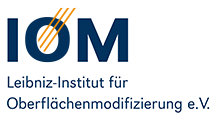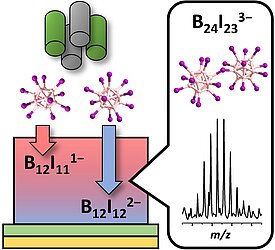While reactions between ions and neutral molecules in the gas phase have been studied extensively, reactions between molecular ions of the same polarity remain relatively unexplored. Joint investigations by scientists from the IOM, the University of Leipzig and the University of Wuppertal have now shown that reactions between fragment ions generated in the gas phase and molecular ions of the same polarity are possible by soft landing of both reagents on surfaces. For example, the researchers found that the reactive [B12I11]1- anion can bind to the generally unreactive [B12I12]2- anion if both anions are softly landed on to the surface. The formation of the highly charged [B24I23]3- anion could be detected using ex situ analysis. The reaction between the two anions does not occur in the gas phase and a computational study shows that the triply charged product [B24I23]3- is only metastable in the gas phase. However, the triply charged product is stabilized on a grounded surface. The results show that the generation of novel, highly charged molecular ions on surfaces is possible using ion soft landing. This enables the generation of products, which are difficult or impossible to access in any other way This opens new possibilities for surface modification with molecular ions.
The results have now been published in the renowned journal Angewandte Chemie. More information about the article:
Anion-Anion Chemistry with Mass-Selected Molecular Fragments on Surfaces
F. Yang, K. A. Behrend, H. Knorke, M. Rohdenburg, A. Charvat, C. Jenne, B. Abel, J. Warneke
Angew. Chem. Int. Ed. 10.1002/anie.202109249
https://doi.org/10.1002/anie.202109249

